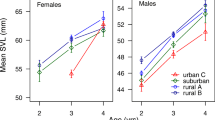Abstract
The occurrence of intersex characteristics in amphibians has been linked to pesticide exposure in the laboratory and proximity to agricultural activity within natural populations. But, overall, the ecology of amphibian intersex is poorly known and, specifically, its occurrence in many landscape types and regions is unstudied. We offer the first analysis of the frequency of amphibian intersex across a range of land covers representing the major landscape types within a region. We used remotely sensed information to characterize land cover surrounding 4774 potential sampling locations within the Connecticut River Valley. From among these, we selected 24 ponds to collect postmetamorphic green frogs (Rana clamitans) from four land cover types: undeveloped, agricultural, suburban, and urban. Collected males were preserved and, then, prepared gonadal tissue samples were screened for the presence of testicular oocytes. A total of 233 animals was examined. Thirteen percent of all male green frogs had gonads containing testicular oocytes. Sexual abnormalities were not randomly distributed among sites or landscape types. Suburban landscapes had the highest frequency of abnormalities (21%), and both suburban and urban land covers were positively associated with the presence of abnormalities within a population. There was no evidence of a positive association with agricultural land cover. Examination of amphibian intersex across a range of contexts reveals that developed landscapes may be hotspots for abnormal sexual development. This new finding suggests that other mechanisms, not previously considered, could contribute to intersex in natural amphibian populations.


Similar content being viewed by others
References
Cheng TH (1929) A new case of intersexuality in Rana cantabrigensis. The Biological Bulletin 57:412–421
Desbrow C, Routledge EJ, Brighty GC, Sumpter JP, Waldock M (1998) Identification of estrogenic chemicals in STW effluent. 1. Chemical fractionation and in vitro biological screening. Environmental Science and Technology 32:1549–1558
Hayes TB, Haston K, Tsui M, Hoang A, Haeffele C, Vonk A (2002) Feminization of male frogs in the wild: water-borne herbicide threatens amphibian populations in parts of the United States. Nature 419:895–896
Hayes TB, Haston K, Tsui M, Hoang A, Haeffele C, Vonk A (2003) Atrazine-induced hermaphroditism at 0.1 ppb in American leopard frogs (Rana pipiens): laboratory and field evidence. Environmental Health Perspectives 111:568–575
Kloas W, Lutz I, Springer T, Krueger H, Wolf J, Holden J, et al. (2009) Does atrazine influence larval development and sexual differentiation in Xenopus laevis? Toxicological Science 107:376–384
MacKenzie CA, Berrill M, Metcalfe C, Pauli BD (2003) Gonadal differentiation in frogs exposed to estrogenic and antiestrogenic compounds. Environmental Toxicology and Chemistry 22:2466–2475
Mann RM, Hyne RV, Choung CB, Wilson SP (2009) Amphibians and agricultural chemicals: review of the risks in a complex environment. Environmental Pollution 157:2903–2927
McCoy KA, Bortnick LJ, Campbell CM, Hamlin HJ, Guillette LJ Jr, St. Mary CM (2008) Agriculture alters gonadal form and function in the toad Bufo marinus. Environmental Health Perspectives 116:1526–1531
McDaniel TV, Martin PA, Struger J, Sherry J, Marvin CH, McMaster ME, et al. (2008) Potential endocrine disruption of sexual development in free ranging male northern leopard frogs (Rana pipiens) and green frogs (Rana clamitans) from areas of intensive row crop agriculture. Aquatic Toxicology 88:230–242
Murphy MB, Hecker M, Coady KK, Tompsett AR, Jones PD, Du Preez LH, et al. (2006) Atrazine concentrations, gonadal gross morphology and histology in ranid frogs collected in Michigan agricultural areas. Aquatic Toxicology 76:230–245
Pettersson I, Berg C (2007) Environmentally relevant concentrations of ethynylestradiol cause female-biased sex ratios in Xenopus tropicalis and Rana temporaria. Environmental Toxicology and Chemistry 26:1005–1009
Reeder AL, Ruiz MO, Pessier A, Brown LE, Levengood JM, Phillips CA, et al. (2005) Intersexuality and the cricket frog decline: historic and geographic trends. Environmental Health Perspectives 113:261–265
Singh SP, Azua A, Chaudhary A, Khan S, Willett KL, Gardinali PR (2010) Occurrence and distribution of steroids, hormones and selected pharmaceuticals in South Florida coastal environments. Ecotoxicology 19:338–350
Skelly DK, Bolden SR, Holland MP, Freidenburg LK, Freidenfelds NA, Malcolm TR (2006) Urbanization and disease in amphibians. In: Ecology of disease: community context and pathogen dynamics, Collinge S, Ray C (editors), Oxford University Press, pp 153–167
Smith EE, Du Preez L, Gentles A, Solomon KR, Tandler B, Carr JA, et al. (2005) Assessment of laryngeal muscle and testicular cell types in Xenopus laevis (Anura Pipidae) inhabiting maize and non-maize growing areas of South Africa. African Journal of Herpetology 54:69–76
Storrs-Mendez SI, Semlitsch RD (2010) Intersex gonads in frogs: understanding the time course of natural development and role of endocrine disruptors. Journal of Experimental Zoology Part B: Molecular and Developmental Evolution 314B:57–66
Sumpter JP, Johnson AC (2005) Lessons from endocrine disruption and their application to other issues concerning trace organics in the aquatic environment. Environmental Science and Technology 39:4321–4332
Witschi E (1921a) Der hermaphrodismus der frosche und seine bedeutung fir das geschlechtsproblem und die lehre von der inneren sekretion der keimdriisen. Archiv fur Entwicklungsmechanik der Organismen 49:316–358
Witschi E (1921b) Development of gonads and transformation of sex in the frog. American Naturalist 55:529–538
Ying GG, Kookana RS, Ru YJ (2002) Occurrence and fate of hormone steroids in the environment. Environment International 28:545–551
Acknowledgments
We thank the dozens of landowners who generously provided access to their properties. We thank M. Holland and T. Langkilde for help with fieldwork, and M. Schadt for assistance with histological preparations. M. Rogalski and two anonymous reviewers provided helpful comments on an earlier version of the manuscript. This research has been supported by grants from the Richard P. Garmany Fund of the Hartford Foundation for Public Giving, the Connecticut Institute of Water Resources, the National Science Foundation, and a Multiple University Research Initiative from the Army Research Office.
Author information
Authors and Affiliations
Corresponding author
Rights and permissions
About this article
Cite this article
Skelly, D.K., Bolden, S.R. & Dion, K.B. Intersex Frogs Concentrated in Suburban and Urban Landscapes. EcoHealth 7, 374–379 (2010). https://doi.org/10.1007/s10393-010-0348-4
Received:
Revised:
Accepted:
Published:
Issue Date:
DOI: https://doi.org/10.1007/s10393-010-0348-4




